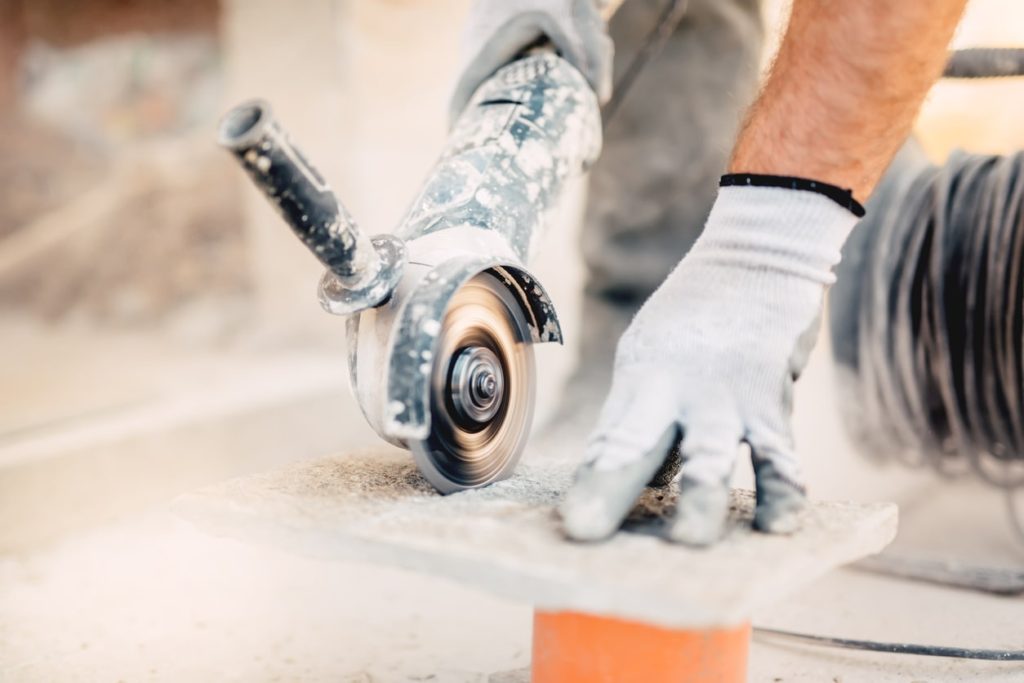Words: Paul Guth, President of Product Development, iQ Power Tools
Photos: iQ Power Tools
Every day, thousands of individuals wake up and prepare for work “at the shop” or on the job site. They may be beginning an extensive retrofit of a shopping mall, or perhaps, they are going to the city to finish off that exposed brick wall in a luxury apartment. Or even beginning the creation of stone/brick walkways in a new housing development (or simply removing timeworn, deteriorated mortar). Whatever their day may have in store, aside from the scaffolding, filling joints, mixing, matching, and mortaring, masons need to take time to get serious about their respiratory safety. Your exposure to silica is real, whether using stationary or handheld saws, grinders, or jackhammers.
Just a few years after the OSHA Silica Standard Rule (2019) took effect, mason contractors could be letting down their guard in compliance… or the newcomers are taking the hazards to heart and heeding the rules. Let’s bring the conversation back to the table!
Respirable crystalline silica is a dangerous hazard that millions of workers are unknowingly exposed to every year. Of an estimated 2 million workers, 840,000 are exposed to an amount of silica that exceeds the permissible exposure limit or the amount of exposure deemed safe. 90% of the individuals exposed to this material are employed in the construction industry.
The Occupational Safety and Health Administration (OSHA) and the National Institute for Occupational Safety and Health (NIOSH) have identified exposure to silica as a health hazard to workers involved in finishing and installing stone, brick, concrete, and even artificial stone, both in fabrication shops and on-site. This hazard can be mitigated with simple and effective dust controls in most operations.
Professionals serious about OSHA compliance, site contamination, and employee safety know how important it is to enforce strict standards relative to airborne hazards like silica or other harmful materials, like asbestos. The safest job sites are those where every employee is actually looking out for each other by reporting accidents, maintaining equipment, and following regulations.
Silica education and awareness should be paramount to everyone’s safety plan, every day, every job site.
KNOW THE HAZARD
Crystalline silica is an extremely common mineral found in granite, sandstone, quartzite, and other rocks and sand that becomes dangerous when disturbed. Finished natural and manufactured stone products, porcelain, and ceramic tile products do not pose a health hazard themselves. It is the fabrication and processing of these products that will generate dust, exposing you to crystalline silica (quartz). Cutting, sawing, grinding, breaking, crushing, drilling, or sanding generates fine silica dust that, unless contained, will dangerously contaminate the air.
Surfacing materials are not always the only culprit on the job site to pose exposure. Mixing mortar can create a “dusty” hazard, too. These products, for the most part, produced with cement or sand aggregate, are comprised of silica as well.
Inhalation of respirable crystalline silica can lead to respiratory diseases such as chronic obstructive pulmonary disease (COPD) or silicosis. Silicosis causes inflammatory damage in areas affected by silica, causing scar tissue to form over critical lung components.
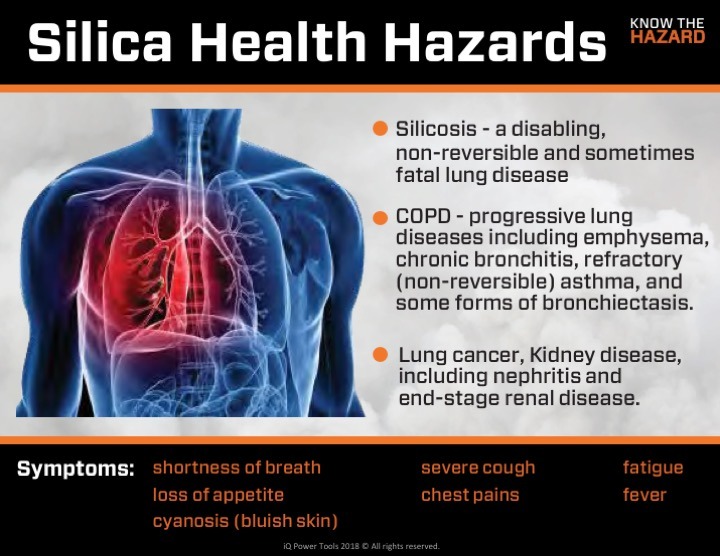
KNOW THE STANDARD
The 2016 OSHA Silica Standard limits silica exposure to a Permissible Exposure Limit (PEL) of 50 micrograms of respirable crystalline silica per cubic meter of air or 50 µg SiO2/m³ over an eight-hour time-weighted average (TWA). Table 1 identifies occupational exposure to silica and work practices and specified engineering control methods to limit exposure. Employers who follow the requirements of Table 1 are not required to measure silica exposure through air monitoring. OSHA recognizes using tools equipped with a water delivery system that supplies a continuous stream or spray of water at the point of impact or using tools equipped with a commercially available shroud and dust collection system as the work practice control methods which safely limit silica exposure.
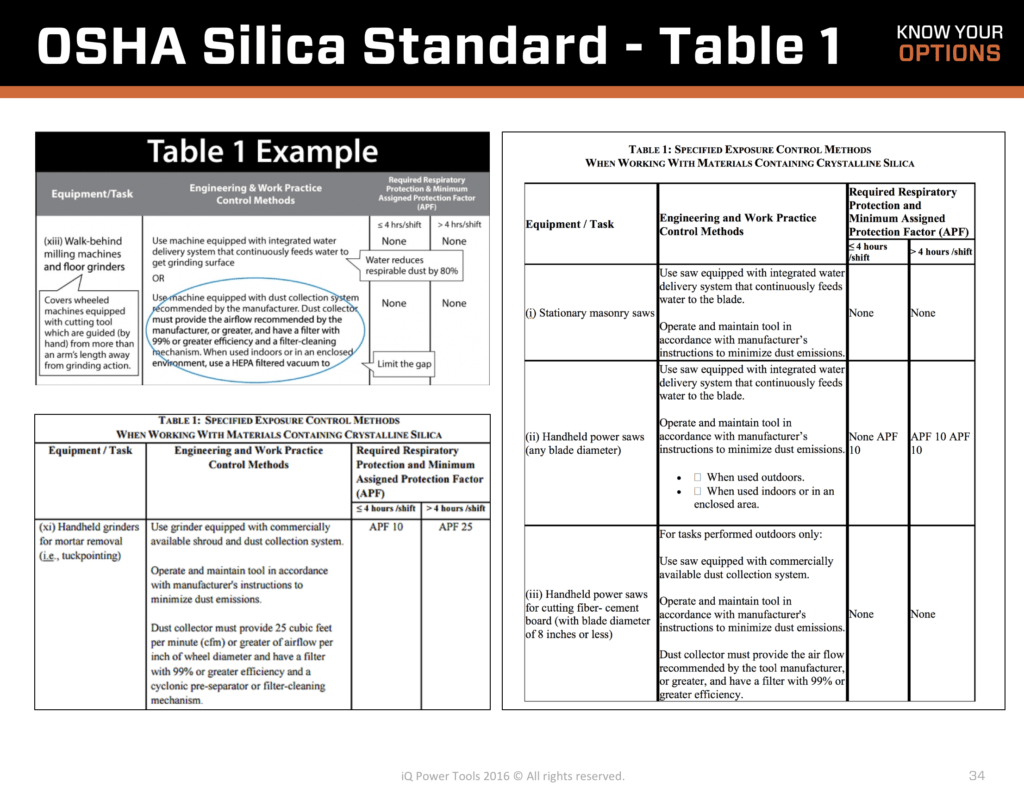
There are alternative exposure control methods available, giving contractors more flexibility in their choice of work practices and tools. These methods require additional control measures to be in compliance with the OSHA Silica Standard. For alternative control methods, the following apply as explained in the OSHA Silica Standard:
- Permissible Exposure Limit: The employer shall ensure that no employee is exposed to an airborne concentration of respirable crystalline silica in excess of 50μg/m3 calculated as an 8-hour TWA
- Exposure Assessment: The employer shall assess the exposure of each employee who is or may reasonably be expected to be exposed to respirable crystalline silica at or above the action level in accordance with either the performance option in paragraph (d)(2)(ii) or the scheduled monitoring option in paragraph (d)(2)(iii) of Table
- Performance Option: The employer shall assess the 8-hour TWA exposure for each employee on the basis of any combination of air monitoring data or objective data sufficient to accurately characterize employee exposures to respirable crystalline silica.
KNOW YOUR EXPOSURE
One way to determine silica exposure is through air monitoring. To many, this may seem like a complicated, expensive process. Actually, it’s fairly easy once one understands what is involved.
Air monitoring equipment will measure the air quality in a worker’s breathing area to determine silica exposure during a specific work practice. Air monitoring uses a battery-operated vacuum attached to an operator’s shirt collar, collecting air samples right where the operator breathes.
Another way to determine silica exposure is by using objective data provided by tool manufacturers. OSHA defines Objective Data as “information, such as air monitoring data from industry-wide surveys or calculations based on the composition of a substance, demonstrating employee exposure to respirable crystalline silica associated with a particular product or material or a specific process, task, or activity. The data must reflect workplace conditions resembling or with a higher exposure potential than the processes, types of material, control methods, work practices, and environmental conditions in the employer’s current operations.” When a manufacturer tests its equipment, if the work practice and materials used match the job site conditions, OSHA will allow this data to be used as objective data as part of a written silica exposure control plan.
Once you learn about exposure levels, you can decide what options are best suited to control silica exposure on your job sites or in your shop.
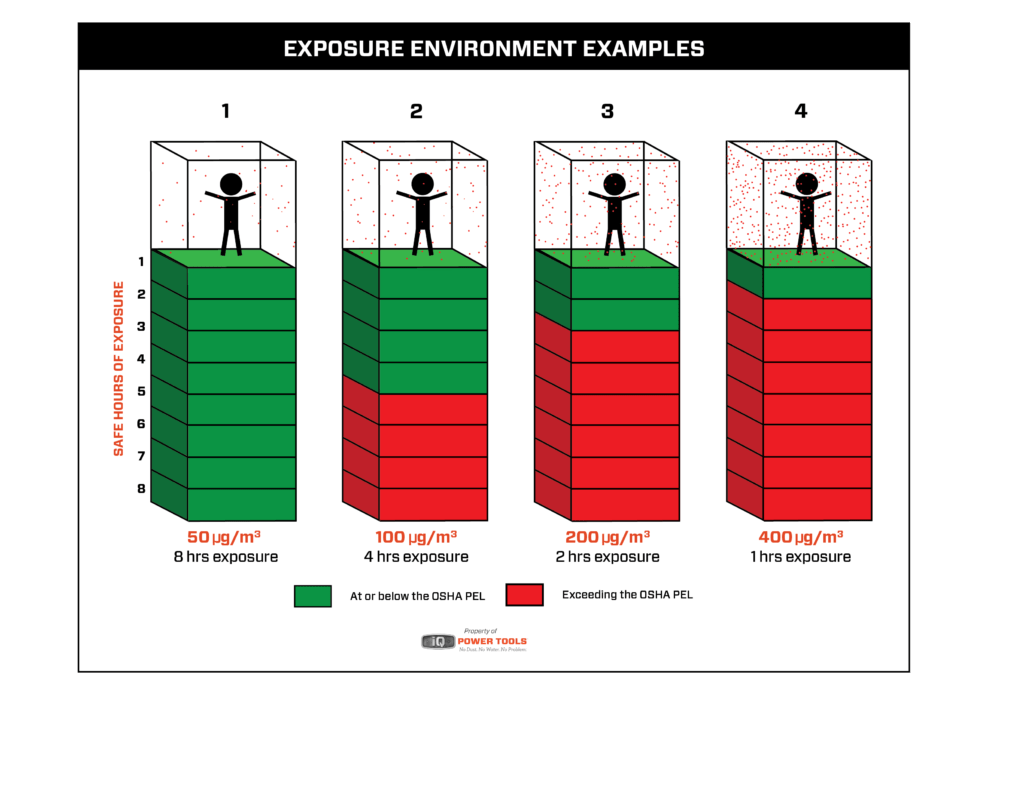
KNOW YOUR MATERIAL
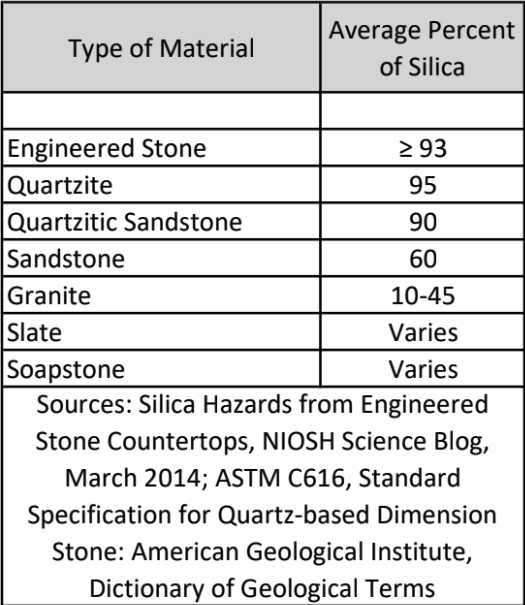
“Check Twice, Cut Once”. The old saying doesn’t just prevent mismeasurement; it’s also a reminder to check exactly what you’re cutting into. Stone and quartz materials contain high amounts of natural mineral silica. Exposure varies by stone type. Silica exposure can vary depending on the silica content of porcelain or ceramic material being used.
Controlled tests of cutting tile show that airborne emissions of crystalline silica and metals are strongly related to their concentrations in tile.1. If you’re not sure if a product contains crystalline silica, check the manufacturer’s Safety Data Sheet (SDS).
KNOW YOUR OPTIONS
Wet cutting and dry cutting without a vacuum have been the main applications for cutting tile materials and fabricating surfaces for decades. But that is changing. The team at iQ Power Tools, manufacturer of power tools with integrated dust collection systems has studied silica for almost 25 years. Based on time alone, they must know dust. Seeing the need to reduce silica exposure on job sites led to the development of an innovative line of power tools with integrated dust collection systems. These tools have been objectively tested to capture up to 99.5% of the harmful silica dust generated from cutting stone and tile. iQ Power Tools recently unveiled the iQ426HEPA, a patent-pending, cyclonic filtration system designed to allow less than 1% of incoming dust to ever reach the filter; keeping the filter virtually dust-free and the vacuum airflow strong.
Whether you’re using a saw, grinder, or a high-speed polisher, it’s essential to wear personal protective equipment (PPE) such as protective eyewear and ear attenuators. You should also know exactly what you’re cutting into, so you can implement proper control methods when exposing hazardous materials.
Whether you’re splitting stone pavers or cutting blind into a wall, you should be cautious about generating airborne contamination that could contain silica dust or asbestos particles. Whether you’re using hand or power tools, it’s important to follow the necessary precautions to protect against any unknown airborne contamination.
Remember, awareness and education ensure prevention and safety, so if you need a refresher course, take one. Your lungs will thank you.

1 Exposures To Crystalline Silica and Metals in Ceramic and Glass Tile” Report prepared By: Environmental Health & Engineering, Inc. November 2017
